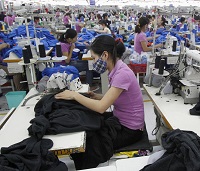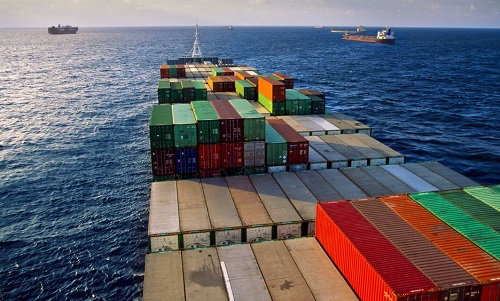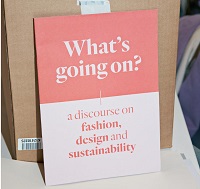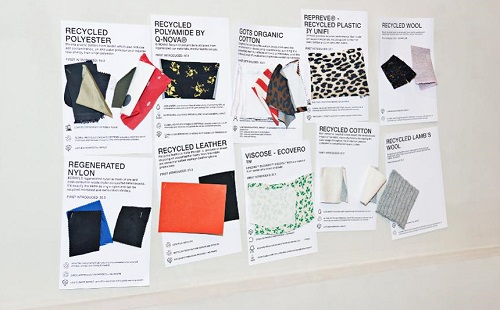FW
Mango has decided to appoint Margarita Salvans as a new member of the company’s Steering Committee in the role of Chief Financial Officer.The new executive, who has worked for the company since 2013, has occupied various positions of responsibility in the store provisioning and management control departments and until now has been in charge of the finance department, where she has provided support to the General Management during the company’s transformation process.
Margarita Salvans takes over from Josep Barberá in finance management, who has decided to end his time at the company in order to undertake a personal project.
Salvans is the second woman to be appointed to the Steering Committee, after Elena Carasso, director of the e-Commerce and Customer departments.
With a long professional career, Salvans previously worked for Boston Consulting Group and Caixa Cataluña, where she was responsible for the areas of pricing and management control during the process of the bank’s merger.A graduate in Business Administration and Management from Universidad Pompeu Fabra in Barcelona, she completed an MBA at the IESE Business School.
According to a report by NASA, The Massachusetts Institute of Technology (MIT) has come up with a COVID-19 sensor that can be embedded into the garment of the wearer. The lightweight sensor is thin enough to be integrated within flexible fabric including polyester majorly used in athleticwear.
These waterproof sensors are responsible for monitoring the vital signs of the body like respiratory rate, heart rate and body temperature. These are very thin and therefore protect the aesthetics of the garment design. Moreover, these are easily detachable to be used with different garments while also being machine washable.
The sensor can monitor the vital signs of the patients in chronic condition and requires regular checkups. The process can eliminate the manual need for performing the task while automating the process and also keeping the medicines free for other tasks and patients.
The individuals can also themselves collect the data and send it to their doctors who can then remotely monitor the condition. As per Techcrunch, the development was being conducted for designing a prototype that can be connected with the smart phone. The innovation is planned to be mass produced together in partnership with China.
It has applications in different fields including sports industry, health industry and space for monitoring the vital signs of the wearer. The funding for the study was received by MIT Media Lab Space Exploration Initiative,
Artistic director Alessandro Sartori is experimenting with a new format and a new date for the Phygital S/S 2021 as coronavirus upends Milan Men's Fashion Week.
The Ermenegildo Zegna Group is marking its 110th anniversary this year, but artistic director Alessandro Sartori is looking to the future rather than the past as he experiments with a new format to present the brand’s spring/summer 2021 collection in July.
This is a significant step for the company, which is the first to reveal it will show in July, and one that may set a precedent in the men’s wear arena. As reported, last month Italy’s Camera Nazionale della Moda said that the spring 2021 men’s shows and presentations slated for June 19 to 23 will run in September during Milan Women’s Fashion Week, which is expected to start on Sept. 22 and end on Sept. 28.
The first quarter net earnings of American footwear company Skechers USA have declined by 54.9 per cent as its operations suffered from disruptions resulting from the global coronavirus crisis.
For the first quarter ended March 31, 2020, the California-based company reported total net earnings of $49.1 million, down from $108.8 million in the same period in the previous year.
Skechers’ quarterly sales declined by 2.7 per cent from $1.28 billion to $1.24 billion, as a 6.8 per cent decline in international sales was partially offset by a 2.9 per cent rise in sales in the company’s domestic business.
Its domestic wholesale revenues increased by 9.0 per cent, while the direct-to-consumer business saw a 4.2 per cent decline. Comparable same store sales in the direct-to-consumer channel fell 8.1 per cent, reflecting a 4.7per cent decline in the U.S. and a 16.6 per cent decrease internationally.
Texworld USA summer edition to go online The summer edition of Texworld USA, the fabric sourcing event run by Messe Frankfurt, will go digital for the first time this July.
The event, in addition to Messe Frankfurt's Apparel Sourcing USA and Home Textiles Sourcing Expo, will take place via a live digital platform from July 21 through 23.
The new digital event will feature an online showroom with products from a variety of international and domestic exhibitors. A chat feature will allow online participants to speak with representatives about specific requirements, factory options and more.
Its comprehensive educational program will also be available digitally, covering topics including sustainability initiatives and environmental and ethical impacts, as well as business tips and sourcing options during a pandemic.
 Recent statistics reveal, the escalating US-China trade war, rising cost of imports, and consumers’ increasing demand for speed to market, is compelling the country to focus on products ‘Made in the USA.’ Textile and apparel production in the country grew to record high of $28.1 billion in 2018 with more locally made products being sold.
Recent statistics reveal, the escalating US-China trade war, rising cost of imports, and consumers’ increasing demand for speed to market, is compelling the country to focus on products ‘Made in the USA.’ Textile and apparel production in the country grew to record high of $28.1 billion in 2018 with more locally made products being sold.
Lack of visibility in US textile and apparel manufacturers
Office of Textiles and Apparel (OTEXA) stats reveal the total value of US textile and apparel exports increased by 20 per cent to $22.9 billion in 2019. However, as noted by a recent OTEXA analysis, despite this strong performance, textile and apparel manufacturers in US are hardly visible on the world trade map.
The analysis suggests, US manufacturers display a relatively high concentration of geographic locations. Around 61 per cent of self-reported yarn manufacturers in the country are from North Carolina, followed by South Carolina, which accounts for another 11 per cent. This concentration of the yarn manufacturers in the South is attributed to the abundant cotton supply in that region.
Secondly, the country is witnessing the emergence of many large-size textile mills its apparel manufacturers are predominantly small and medium-sized. These textile mills have a high concentration of factories with over 100 employees, whereas over half the apparel mills in OTEXA database reported having less than 50 employees.
These textile mills have a high concentration of factories with over 100 employees, whereas over half the apparel mills in OTEXA database reported having less than 50 employees.
Micro factories merge as labor costs increase. Also, due to increasing labor costs, US apparel mills are focusing on niche markets like designer-based micro-factories. These factories typically provide customized services, ranging from proto-typing to sample production.
The two most popular types of vertical integration amongst the textile and apparel mills in the US include fabric and apparel and fabric and technical textiles. Amongst these, fabric mills are the most actively engaged in vertical integration strategy–around one-third of them reported also making apparel, technical textiles, or home textiles. Additionally, 20 per cent technical textile manufacturers in the OTEXA database were reported to have incorporated an apparel component to their product portfolio.
Serving customers through value-adds
Moreover, these mills have shifted from only making products to offering various value-added services. The OTEXA survey shows, majority of companies included in the ‘Made in the USA’ database have in-house design capabilities. These mills aim to serve their customers’ needs rather than just making physical products.
Fifth, according to OTEXA database, of the 122 US textile and apparel manufacturers, around 70.5 per cent were engaged in exports. Of this, 76 per cent textile mills were more actively engaged in exports than apparel manufacturers.
Diverse markets for apparel and technical textiles
The survey also revealed that the Western Hemisphere is the dominant export market for US yarn, fabric, and home textile mills, whereas the export markets for US apparel mills and technical textile producers are relatively more diverse. As many as 77 per cent yarn manufacturers included in the OTEXA database reported exporting three or more different markets in the world. Likewise, around 40 per cent of fabric, home textiles, and technical textiles mills did the same.
A high percentage of textile and apparel mills reported using the NAFTA and CAFTA-DR trade agreements for their exports. This was particularly the case with yarn producers 83 per cent of whom reported leveraging these agreements for their exports.
 Brands and manufacturers are debating as to whether sustainability initiatives will take a back seat after COVID-19, as economic resurgence takes precedence. The fifth Fashion Transparency Index published by Fashion Revolution Week explores how brands, manufacturers and thought-leaders are analysing current metrics and adapting sustainability and climate change initiatives in the face of COVID-19.
Brands and manufacturers are debating as to whether sustainability initiatives will take a back seat after COVID-19, as economic resurgence takes precedence. The fifth Fashion Transparency Index published by Fashion Revolution Week explores how brands, manufacturers and thought-leaders are analysing current metrics and adapting sustainability and climate change initiatives in the face of COVID-19.
Secure future for inherently sustainable brands
One of the views proposed in this index is that of Francois Souchet, Lead, Make Fashion Circular at the Ellen Macarthur Foundation. Souchet believes the sustainable transformation plans of those brands, who have adopted waste management and sustainability initiatives at the core of their businesses, are secure.
Echoeing this view, Hakan Karaosman, fashion supply chain and sustainability expert at the United Nations Economic Commission for Europe declares in future, only those brands that incorporate inherent sustainability will survive. Karasoman advocates for lean, simple and transparent supply chains during this crisis,
future, only those brands that incorporate inherent sustainability will survive. Karasoman advocates for lean, simple and transparent supply chains during this crisis,
Karl-Hendrik Magnus, Senior Partner at McKinsey and Company in Frankfurt and leader of the Apparel, Fashion & Luxury Group point out though sustainability had dropped off the agenda for the past few weeks, well-performing companies in Western Europe can now bring sustainability back onto the agenda by communicating clearly their brand purpose and commitment to the safety of customers, staff and those involved in the industry must continue.
Smart solutions and closer relations
Magnus expects sustainability shift to accelerate post COVID 19. He also expects COVID-19 to accelerate close partnerships between brands and suppliers across all market segments, from value products to luxury.
Eva Kruse, CEO of Global Fashion Agenda expects the industry introduce to some smarter solutions to make use of all these great products. She also expects brands to build closer relationships with their suppliers across the value chain for better insights and impacts.
Smarter use of funds
Céline Semaan, Founder, Slow Factory offers a holistic view of the situation. The fashion industry should change everything from its fast-paced fashion calendar to the overproduction of goods, exploitation of land, labor, and exotic animals, the way it capitalizes on movements such as Earth Day and all efforts around that day/month focusing on profit-driven initiatives. Semaan appeals brands to redirect their marketing budgets into impact funds to support and fund food banks, give out grants to the creative community and support more grassroots nonprofits working in climate and human rights impact.
Ensuring radical transparency in production
The vice president of BOMBYX, Hilmond Hui says interrupted supply of materials post COVID-19 will increase the cost of silk manufacturing by 10 per cent. The manufacturer aims to shift traditional perceptions on the silk industry by offering radical transparency and traceability of how their silk is produced, traded, dyed and constructed.
Hui also urges all manufacturers to look at all available technologies that can be applied to their processes, particularly those that help harness the power of renewable energy, as well as energy reduction. According to him, both brands and consumers will begin to be more scrutinizing when it comes to where, how, and why things are made.
Demonstrating the precarious position of manufacturers at this time, Sanjeev Bahl, CEO and Founder of Saitex explains pricing matrix will be a battlefield in the coming months. According to him, an overabundance of inventory will cause issues, such as discounting and consequently slashed margins. He therefore, advises brands to get to a manageable size and be in a position to say no to excess inventories.
Textiles major Welspun has resumed operations partially after receiving necessary permissions from district authorities. The firm has started operations at its manufacturing facilities in Vapi and Anjar in Gujarat.
The Ministry of Home Affairs, under the revised guidelines for the extended lockdown till May 3, had allowed industrial units in rural areas or outside municipal limits to resume operations partially after 20 April, under strict hygiene and safety conditions.
Welspun had decided to temporarily close its manufacturing units on March 24 till further notice following announcement of nationwide lockdown to curb spread of coronavirus pandemic.
The United States White House National Security Council (NSC) thanked Taiwan for its swift delivery of masks to countries hardest hit by the pandemic. Furthermore, Microsoft founder Bill Gates also publicly praised Taiwan’s swift action to fight off Coronavirus as “exemplary”. Even the phrase “TaiwansHelping” is turning into a hashtag keyword on Twitter. Taiwan has transformed from importing country for surgical mask to the second-largest surgical mask producer worldwide with daily production capacity of 15 million units.
With years of research and development efforts in functional textiles, Taiwan textile industry has accumulated experience and technology that allows Taiwan government to form a national epidemic prevention team in the fight against COVID-19 at short notice.
Through the efforts by manufacturers like WEB-PRO Corp, Nan Liu Enterprise Co, Eclat Textile and Makalot Industrial on the National Team for Hazmat and Protective Clothing Taiwan successfully develops and produced the level 3 protective suit in just one month. In the period from March to April, over one million units of isolation gown and 100 thousand units of protective suits were manufactured.
Taiwan has donated 15 million surgical masks to support medical staffs in countries with severe coronavirus outbreak, and will continue to provide support to the international community.
Pakistan Textile Exporters Association (PTEA) has asked for expeditious disbursement of all outstanding refunds as the Covid-19 pandemic has significantly impacted cash flows, squeezing the financial streams.
Commenting on the prevailing situation chairman PTEA Sohail Pasha expressed serious concerns over unnecessary delay in disbursement of pending refunds of exporters despite the commitment of the government for liquidation of Rs 100 billion pending refund claims to save the export industry from the adverse impacts of COVID-19 pandemic.
PTEA's patron-in-chief Khurram Mukhtar says most affected value chain for Pakistan was textiles and apparel which had faced large scale cancellation or deferral of export orders. He demanded restoration of zero-rated regime for five export sectors and sustainable energy tariff for five years. He urged for payment of textile policy incentives Technology Up-gradation Fund (TUF) and Mark-up Support subsidy to keep industrial wheels running and save the livelihood of millions.
Vice Chairman PTEA Haris Yousaf urged the government to take preventive measures and develop strategy to protect the pace of economic and trade progress of Pakistan from likely impacts of world economic slowdown.












